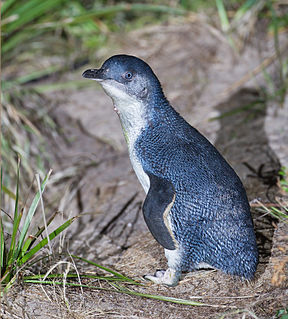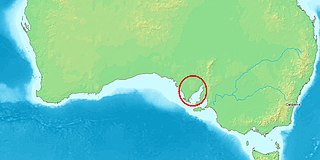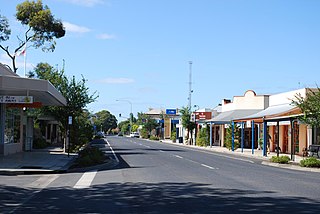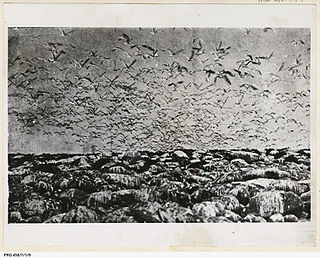Related Research Articles

The little penguin is the smallest species of penguin. It grows to an average of 33 cm (13 in) in height and 43 cm (17 in) in length, though specific measurements vary by subspecies. It is found on the coastlines of southern Australia and New Zealand, with possible records from Chile. In Australia, they are often called fairy penguins because of their small size. In New Zealand, they are more commonly known as little blue penguins or blue penguins owing to their slate-blue plumage; they are also known by their Māori name kororā.

Sir Joseph Banks, 1st Baronet, was an English naturalist, botanist, and patron of the natural sciences.

The Spencer Gulf is the westernmost and larger of two large inlets on the southern coast of Australia, in the state of South Australia, facing the Great Australian Bight. It spans from the Cape Catastrophe and Eyre Peninsula in the west to Cape Spencer and Yorke Peninsula in the east.

Botany is a suburb in south-eastern Sydney, in the state of New South Wales, Australia. Botany is located 11 kilometres south of the Sydney central business district and is part of the Bayside Council.

Penola is a town in the Australian state of South Australia located about 388 kilometres (241 mi) southeast of the state capital of Adelaide in the wine growing area known as the Coonawarra. At the 2016 census, town of Penola had a population of 1,312.
The South Australian Company, also referred to as the South Australia Company, was formed in London on 9 October 1835, after the South Australia (Foundation) Act 1834 had established the new British Province of South Australia, with the South Australian Colonization Commission set up to oversee implementation of the Act.
English Island is an island off the coast of Eyre Peninsula in South Australia. It is a part of the Sir Joseph Banks Group and close to Sibsey Island. The island is most notable for its large colony of sea lions, and for a secession movement started by the eccentric and self-styled "Sir Ralph Styles of English Island" in 1954.

For Pennshaw in the UK, see Penshaw

Loch Vennachar was a three-masted iron sailing ship (clipper) that operated between Great Britain and Australia between the late 19th century and 1905. The name was drawn from Loch Venachar, a loch which lies to the south-west of the burgh of Callander, in the Stirling region of Scotland. It is understood to mean "most beautiful lady" in Scottish Gaelic.

The County of Flinders is one of the 49 cadastral counties of South Australia. The county covers the southern part of the Eyre Peninsula “bounded on the north by a line connecting Point Drummond with Cape Burr, and on all other sides by the seacoast, including all islands adjacent to the main land.”

The Sir Joseph Banks Group is an archipelago in the Australian state of South Australia located in Spencer Gulf about 20 kilometres (12 mi) off the eastern coast of the Eyre Peninsula. It consists of 21 islands of which eighteen are in the Sir Joseph Banks Group Conservation Park while the surrounding waters are in the Sir Joseph Banks Group Marine Park. It is considered to be an important seabird breeding site.
Hopkins Island is an island located in Spencer Gulf off the east coast of Jussieu Peninsula on Eyre Peninsula in South Australia approximately 32 km (20 mi) south-east of Port Lincoln. It was named by Matthew Flinders in memory of John Hopkins who was one of the eight crew lost from a cutter that capsized on 21 February 1802. Since 2004, the island has been part of the Memory Cove Wilderness Protection Area.

Dangerous Reef is an island and reef system located in Spencer Gulf in the Australian state of South Australia about 32.5 kilometres (20.2 mi) east-south east of the city of Port Lincoln. It is the southernmost member of the Sir Joseph Banks Group. It has been the site of a navigation aid since 1911. It is notable as the site of a breeding colony of Australian sea lions. The waters adjoining its shore are notable as a place to view great white sharks to the extent that it was both a popular gamefishing and shark cage diving venue during the twentieth century, and was used to film footage for the following motion pictures – Blue Water White Death and Jaws. The island has enjoyed protected area status since 1900 and it has been part of the Sir Joseph Banks Group Conservation Park since 1989.

County of Carnarvon is a cadastral unit located in the Australian state of South Australia which covers the full extent of Kangaroo Island. It was proclaimed in 1874 by Governor Musgrave in response to the demand for agriculture land on Kangaroo Island.

The County of Jervois is a cadastral unit in the Australian state of South Australia that covers land on the east coast of the Eyre Peninsula. It was proclaimed on 24 January 1878 and named after William Jervois, the Governor of South Australia from October 1877 to January 1883.
Governor Gawler was built in 1840. This made her the first sailing vessel built in South Australia. She traded between Port Lincoln and Port Adelaide, but also carried cargo and passengers to Melbourne and Hobart Town, including soldiers, police, criminals, an executioner, as well as numerous civilians. When she wrecked in 1847, she was the first South Australian ship to be wrecked.
Spilsby Island is one of the largest islands in the Sir Joseph Banks Group in Spencer Gulf, South Australia. It is privately owned, has no permanent human residents and is grazed by sheep. The island was used for the breeding of sheep by James Hunter Kerrison, then for the breeding of horses, sheep, pigs and cattle by W. E. Scruby in the early 20th century. Shearers travelled to the island to shear the sheep. The island's soil has been enriched by the deposition of guano by seabirds. Land allotments and a few shacks are concentrated along the northern coast of the island. Butterfish Bay is on the northern coast and Hawknest Bay is on the eastern coast.
Boucaut Island is a small, uninhabited island in the Sir Joseph Banks Group in South Australia's Spencer Gulf. It lies 1.2 km northeast of Spilsby Island. Seal Rock lies 250 metres southeast of Boucaut Island.

Stickney Island is an uninhabited island of the Sir Joseph Banks Group located in Spencer Gulf, South Australia.
Reevesby Island is a small, uninhabited island in the Sir Joseph Banks group of islands in southern Spencer Gulf, South Australia. Since 2018, a group of volunteers now known as the Friends of Reevesby Island have been restoring the old homestead on the island, which was inhabited until it became a conservation park in 1974. Author and local historian Eric Kotz is a member. The homestead is encircled by a low fence which was built to keep the island's resident Tiger snakes and Death adders away from the island's human inhabitants. The island is one of the largest in the Sir Joseph Banks Conservation Park and is home to many unique species including greater stick-nest rats, hooded plovers, little penguins and Cape Barren geese.
References
- ↑ "Valuable Book For Institute". Port Lincoln Times (SA : 1927 - 1954). 7 May 1937. p. 7. Retrieved 20 June 2021.
- ↑ "SIR JOSEPH BANKS ISLANDS". Sydney Mail (NSW : 1912 - 1938). 10 March 1937. p. 41. Retrieved 22 June 2020.
- ↑ "Seeing The Islands Of the S.A. Coast". Advertiser (Adelaide, SA : 1931 - 1954). 13 April 1935. p. 9. Retrieved 20 June 2021.
Coordinates: 34°35′43″S136°15′10″E / 34.59528°S 136.25278°E